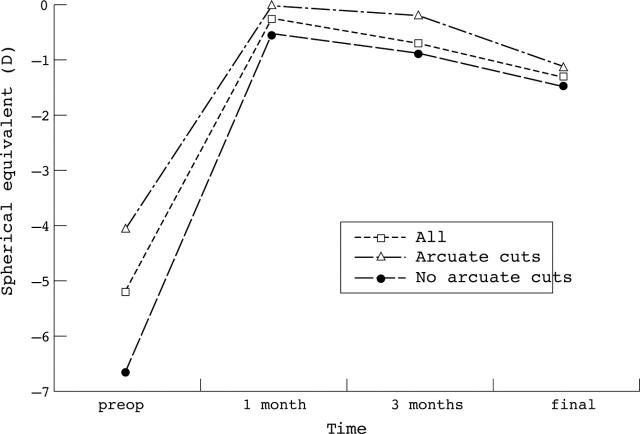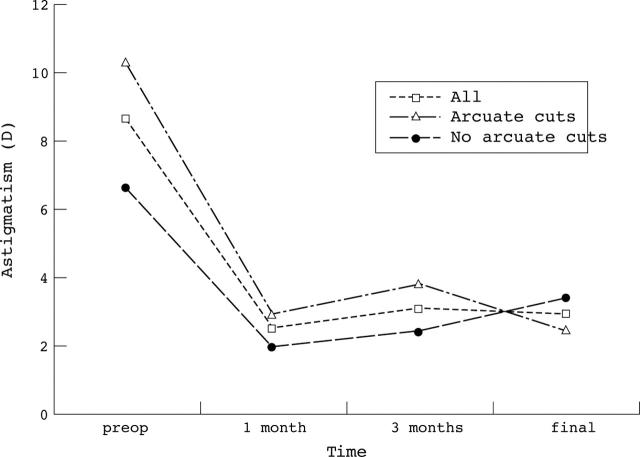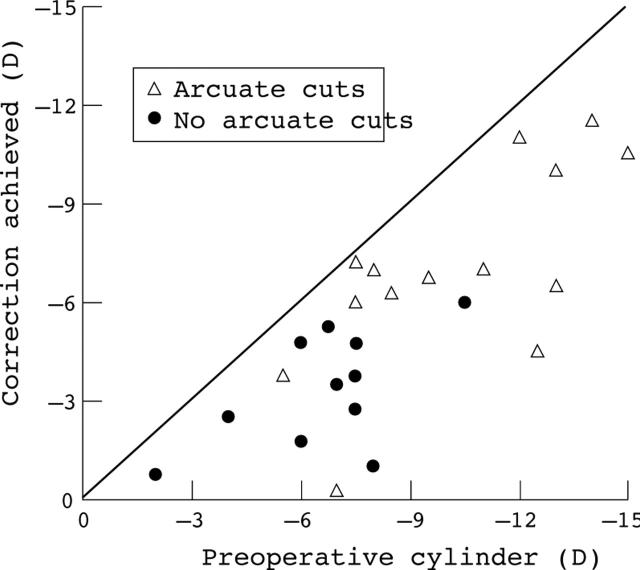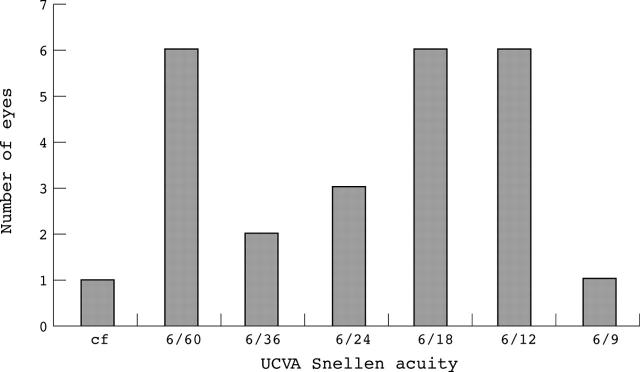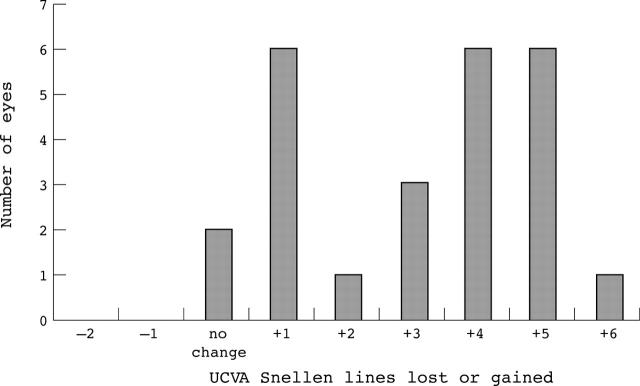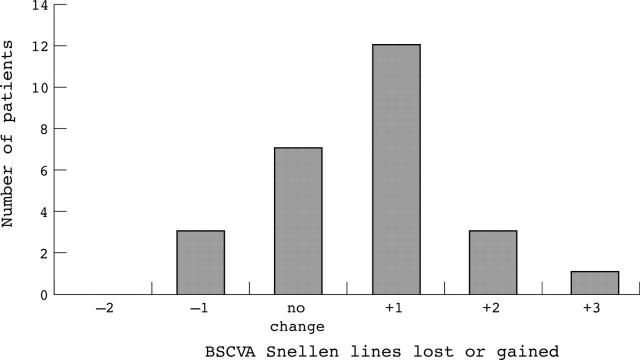Abstract
AIMS—To report the results of a series of patients who were treated with LASIK to correct post penetrating keratoplasty ametropia. METHODS—26 eyes of 24 patients underwent LASIK to correct astigmatism and myopia after corneal transplantation; 14 eyes also received arcuate cuts in the stromal bed at the time of surgery. The mean preoperative spherical equivalent was −5.20D and the mean preoperative astigmatism was 8.67D. RESULTS—The results of 25 eyes are reported. The mean 1 month values for spherical equivalent and astigmatism were −0.24D and 2.48D respectively. 18 eyes have been followed up for 6 months or more. The final follow up results for these eyes are −1.91D and 2.92D for spherical equivalent and astigmatism. The patients undergoing arcuate cuts were less myopic but had greater astigmatism than those not. The patients receiving arcuate cuts had a greater target induced astigmatism, surgically induced astigmatism, and astigmatism correction index than those eyes that did not. One eye suffered a surgical complication. No eyes lost more than one line of BSCVA and all eyes gained between 0 and 6 lines UCVA. CONCLUSIONS—LASIK after penetrating keratoplasty is a relatively safe and effective procedure. It reduces both the spherical error and the cylindrical component of the ametropia. Correction of high astigmatism may be augmented by performing arcuate cuts in the stromal bed.
Full Text
The Full Text of this article is available as a PDF (93.2 KB).
Figure 1 .
Change in spherical equivalent with time.
Figure 2 .
Preoperative spherical equivalent v correction achieved at latest follow up.
Figure 3 .
Change in astigmatism with time.
Figure 4 .
Preoperative astigmatism v correction achieved at latest follow up.
Figure 5 .
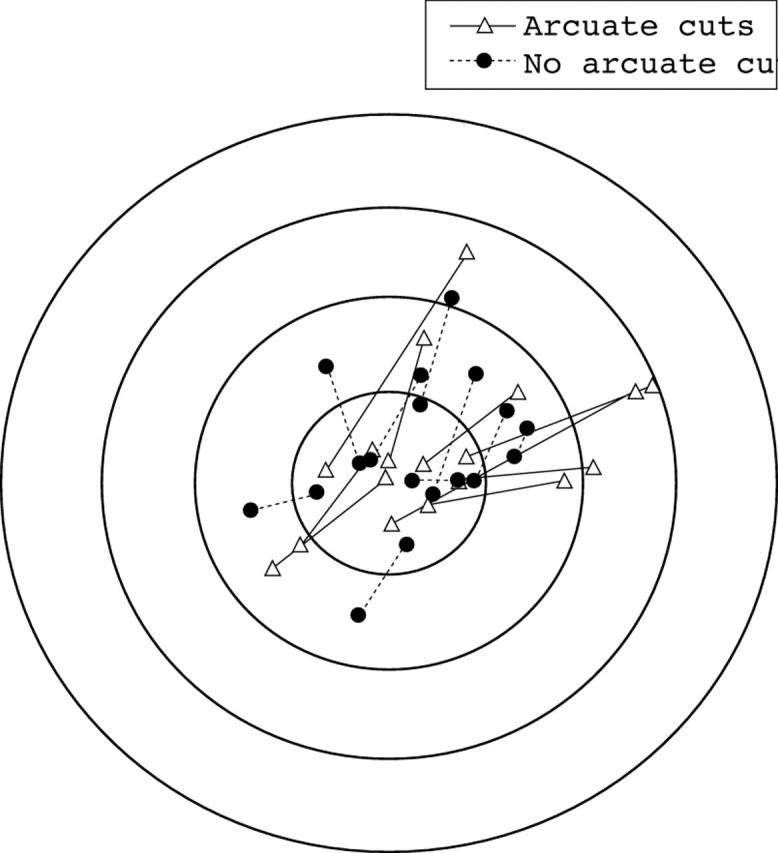
Doubled angle plot of preoperative and postoperative astigmatism. Each concentric circle represents 5D astigmatism magnitude. The lines join the preoperative and postoperative values for a single eye. The ideal plot would have lines radiating from the centre like a cartwheel.
Figure 6 .
Postoperative UCVA at latest follow up.
Figure 7 .
Snellen lines of UCVA lost or gained at latest follow up.
Figure 8 .
Snellen lines of BSCVA lost or gained at latest follow up.
Selected References
These references are in PubMed. This may not be the complete list of references from this article.
- Alpins N. A. A new method of analyzing vectors for changes in astigmatism. J Cataract Refract Surg. 1993 Jul;19(4):524–533. doi: 10.1016/s0886-3350(13)80617-7. [DOI] [PubMed] [Google Scholar]
- Arenas E., Maglione A. Laser in situ keratomileusis for astigmatism and myopia after penetrating keratoplasty. J Refract Surg. 1997 Jan-Feb;13(1):27–32. doi: 10.3928/1081-597X-19970101-09. [DOI] [PubMed] [Google Scholar]
- Krueger R. R., Landry R. J., Assil K. K., Schanzlin D. J. Retrephination keratoplasty for high astigmatism after penetrating keratoplasty. J Refract Surg. 1996 Nov-Dec;12(7):806–808. doi: 10.3928/1081-597X-19961101-14. [DOI] [PubMed] [Google Scholar]
- Lazzaro D. R., Haight D. H., Belmont S. C., Gibralter R. P., Aslanides I. M., Odrich M. G. Excimer laser keratectomy for astigmatism occurring after penetrating keratoplasty. Ophthalmology. 1996 Mar;103(3):458–464. doi: 10.1016/s0161-6420(96)30671-4. [DOI] [PubMed] [Google Scholar]
- Nordan L. T., Binder P. S., Kassar B. S., Heitzmann J. Photorefractive keratectomy to treat myopia and astigmatism after radial keratotomy and penetrating keratoplasty. J Cataract Refract Surg. 1995 May;21(3):268–273. doi: 10.1016/s0886-3350(13)80130-7. [DOI] [PubMed] [Google Scholar]
- Parisi A., Salchow D. J., Zirm M. E., Stieldorf C. Laser in situ keratomileusis after automated lamellar keratoplasty and penetrating keratoplasty. J Cataract Refract Surg. 1997 Sep;23(7):1114–1118. doi: 10.1016/s0886-3350(97)80090-9. [DOI] [PubMed] [Google Scholar]
- Troutman R. C., Lawless M. A. Penetrating keratoplasty for keratoconus. Cornea. 1987;6(4):298–305. doi: 10.1097/00003226-198706040-00013. [DOI] [PubMed] [Google Scholar]
- Tuunanen T. H., Ruusuvaara P. J., Uusitalo R. J., Tervo T. M. Photoastigmatic keratectomy for correction of astigmatism in corneal grafts. Cornea. 1997 Jan;16(1):48–53. [PubMed] [Google Scholar]
- Whitehouse G., Sutton G., Lawless M. A., Rogers C. Refractive keratoplasty for post-graft astigmatism. Aust N Z J Ophthalmol. 1994 Nov;22(4):243–247. doi: 10.1111/j.1442-9071.1994.tb00791.x. [DOI] [PubMed] [Google Scholar]



